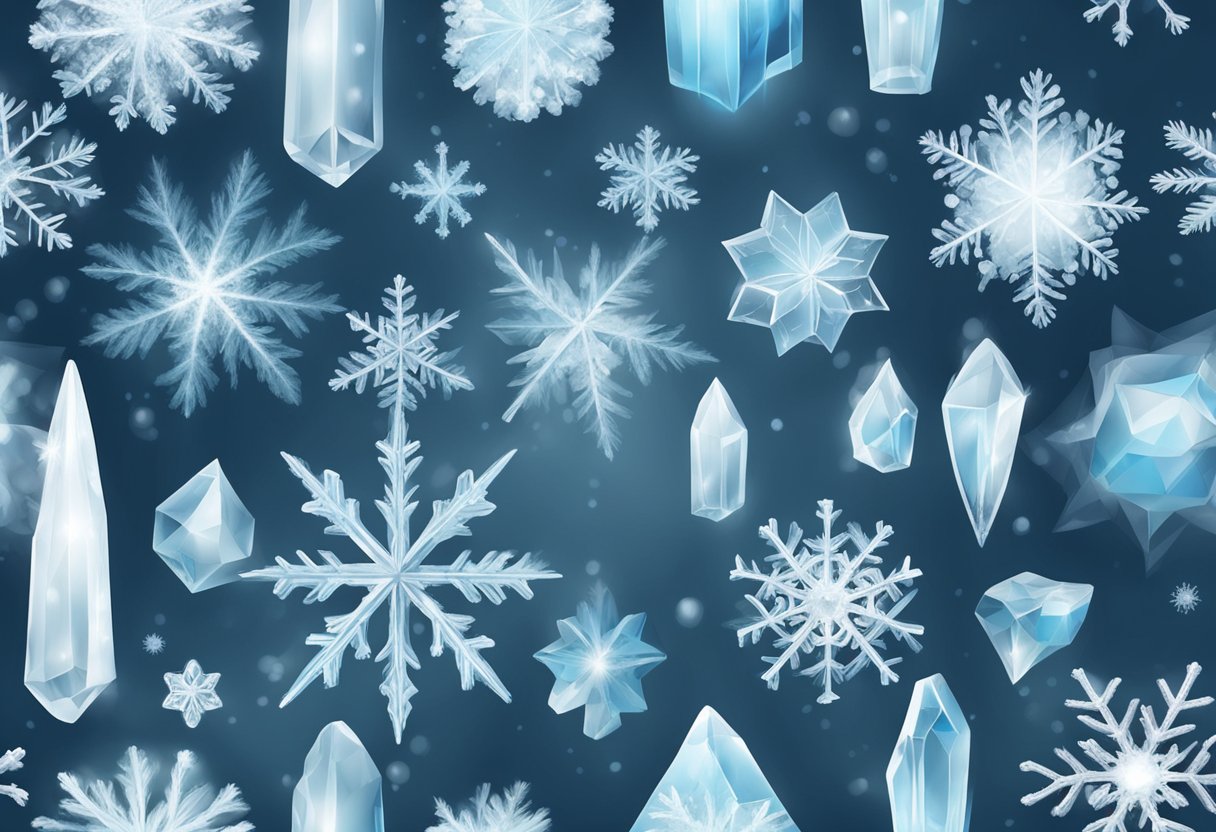Types Of Ice
Ice is a fascinating substance that has captivated scientists and laypeople alike for centuries. It is a solid form of water that forms when the temperature drops below the freezing point of water, which is 0 degrees Celsius or 32 degrees Fahrenheit. Ice has a unique crystalline structure that gives it a variety of properties that make it useful in many different ways.
The formation and properties of ice have been the subject of much study and research over the years. Scientists have discovered that there are many different types of ice, each with its own unique characteristics and properties. Some of the most common types of ice include sea ice, glacial ice, and permafrost, among others. Each of these types of ice has its own unique properties and plays an important role in the natural world.
Key Takeaways
- Ice is a solid form of water that forms when the temperature drops below the freezing point of water.
- Scientists have discovered that there are many different types of ice, each with its own unique characteristics and properties.
- Some of the most common types of ice include sea ice, glacial ice, and permafrost, among others.
Formation and Properties of Ice

Water Molecules and Ice Crystals
Ice is the solid form of water that forms when water molecules freeze and form a crystalline structure. Water molecules are composed of two hydrogen atoms and one oxygen atom and are held together by a covalent bond. In the liquid state, the water molecules are in constant motion and do not have a fixed position. However, when the temperature drops below 0°C (32°F), the water molecules slow down and start to form a crystalline structure, which is known as ice.
The ice crystals are formed when the water molecules arrange themselves in a hexagonal pattern, with each molecule bonded to four other molecules. This creates a lattice structure that is responsible for the solid form of ice. The size and shape of the ice crystals depend on the temperature and pressure conditions during the freezing process.
Freezing Process and Temperature Influences
The freezing process of water is influenced by various factors, including temperature, pressure, and impurities. When water is cooled below its freezing point, the water molecules start to form ice crystals, and the temperature at which this occurs is known as the freezing point. The freezing point of water is 0°C (32°F) at standard atmospheric pressure, but it can vary depending on the pressure conditions.
The density of ice is lower than that of liquid water, which is why ice floats on water. This is due to the fact that the ice crystals have a more open structure than liquid water, which makes it less dense. The phase diagram of water shows the different states of water at different temperatures and pressures. At low temperatures and high pressures, water can exist in a solid form known as ice VII, which has a higher density than regular ice.
In conclusion, the formation and properties of ice are determined by the arrangement of water molecules in a crystalline structure. The freezing process and temperature conditions play a significant role in the formation and properties of ice, including its density and crystal structure.
Types of Ice in Nature
Glacial and Iceberg Formations
Glaciers are large masses of ice that form on land from snow that has accumulated over many years. They can be found in many parts of the world, including Antarctica, Greenland, Canada, and the Himalayas. Glaciers can be several kilometers thick and can move very slowly over time due to their weight and gravity.
When parts of a glacier break off, they can form icebergs. Icebergs are large pieces of ice that float in the ocean and can be several meters above the water surface. Most icebergs come from glacial ice sheets and can be found in polar regions.
Sea Ice Varieties
Sea ice refers to the ice that forms from the freezing of seawater. There are two main types of sea ice: pack ice and fast ice. Pack ice is made up of ice floes that are pushed together by waves and currents. Fast ice is attached to the land and does not move with the ocean currents.
There are also several varieties of sea ice, including nilas, pancake ice, and pressure ridges. Nilas is a thin layer of ice that forms on calm seawater. Pancake ice is made up of circular pieces of ice that are pushed together by waves. Pressure ridges are formed when two ice floes collide and are pushed up against each other.
Freshwater Ice Occurrences
Freshwater ice occurs in lakes, rivers, and other bodies of freshwater. It can form when the temperature drops below freezing and can be several meters thick in some cases. Freshwater ice can also be found in the form of ice caps and ice fields.
The salt content of the water affects the freezing point, so freshwater ice forms at a higher temperature than sea ice. There are also several types of freshwater ice, including grease ice, frazil, and brinicles. Grease ice is a thin layer of ice that forms on the surface of the water. Frazil is made up of small ice crystals that form in the water. Brinicles are icicle-like structures that form under the surface of the water and are filled with briny water.
Overall, there are many different types of ice that can be found on Earth’s surface, each with its own unique characteristics and properties. Understanding these different types of ice is important for understanding the Earth’s climate and how it is changing over time.
Human Interaction with Ice
Ice in Industry and Culinary Uses
Ice has been used by humans for various purposes for centuries. One of the most common uses of ice is for cooling purposes. Regular ice cubes are commonly used to keep drinks and food cold, while nugget ice and crescent ice are preferred by some for their ability to cool drinks quickly without diluting them too much. In the culinary world, gourmet ice has become a trend, with restaurants using different shapes and sizes of ice to enhance the presentation and taste of their dishes.
In addition to cooling, ice is also used in industries such as fishing, where flake ice is used to keep fish fresh during transportation. Dry ice, which is the solid form of carbon dioxide, is used for refrigeration in the medical and food industries. The National Park Service also uses ice for scientific purposes, such as studying the behavior of glaciers and snowflakes.
Ice in Climate Study and Environmental Impact
Ice plays a crucial role in the water cycle and in regulating the Earth’s temperature. Glacial ice, which is found in North America and other parts of the world, provides a record of past climate changes and helps scientists understand the impact of human activity on the environment. The melting of glacial ice due to rising temperatures is also a cause for concern, as it contributes to rising sea levels and other environmental issues.
Amorphous ice, which is a form of ice that lacks a crystalline structure, is also of interest to scientists studying physical chemistry and atmospheric pressure. Ice can exist in various crystalline forms, each with its own unique properties and uses. Hydrogen bonds between water molecules give ice its unique structure and properties, such as its ability to float on liquid water.
Sleet, which is a mixture of rain and snow, can also cause hazardous conditions on roads and sidewalks. It is important for individuals to be aware of the weather conditions and take precautions when driving or walking on icy surfaces.
In conclusion, ice plays a significant role in various aspects of human life, from cooling drinks to studying climate change. Understanding the properties and uses of different forms of ice can help individuals make informed decisions and contribute to a sustainable future.
Climatic and Geological Impact of Ice
Ice has played a significant role in shaping the Earth’s climate and geology. In this section, we will explore two of the major impacts of ice on the planet: ice ages and historical climate change, and erosion and weathering by ice.
Ice Ages and Historical Climate Change
Ice ages are periods of geological time when a significant portion of the Earth’s surface is covered by ice sheets. These periods are characterized by a drop in global temperatures and a corresponding increase in the amount of ice on the planet. The most recent ice age occurred approximately 2.6 million years ago and lasted until about 11,700 years ago.
During ice ages, the climate of the Earth is significantly affected. The drop in temperatures leads to changes in precipitation patterns, which in turn affects the distribution of vegetation and wildlife. The cooling also affects ocean currents, which can have a significant impact on global weather patterns.
The study of ice cores has been instrumental in understanding the historical climate changes that have occurred on the planet. By analyzing the composition of gases trapped in the ice, researchers can reconstruct the temperature and atmospheric conditions of the past.
Erosion and Weathering by Ice
Ice can also have a significant impact on the geology of the planet through erosion and weathering. Glaciers can carve out valleys and canyons, and can also transport large boulders and rocks over long distances. This process is known as glacial erosion.
In addition to erosion, ice can also cause weathering by expanding and contracting as it freezes and thaws. This process, known as frost weathering, can break apart rock and soil, leading to the formation of talus slopes and scree fields.
The impact of ice on erosion and weathering is particularly significant in Europe, where glaciers have shaped the landscape for millions of years. The Alps, for example, are characterized by steep valleys and jagged peaks, which are the result of glacial erosion.
In conclusion, ice has played a significant role in shaping the Earth’s climate and geology. Ice ages and historical climate change have had a profound impact on the planet, while erosion and weathering by ice have shaped the landscape in many parts of the world.






